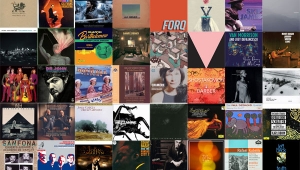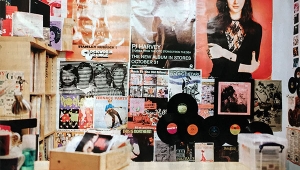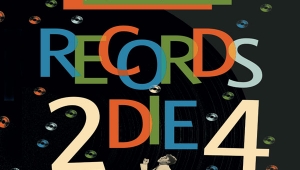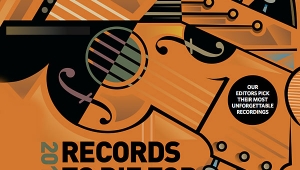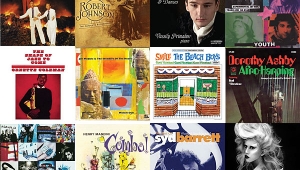| Columns Retired Columns & Blogs |
2008 Records To Die For Page 5
MATTHEW FRITCH
MARK LANEGAN BAND: Bubblegum
Beggars Banquet BBQCD237 (CD). 2004. Mark Lanegan, Chris Goss, prods.; Tracy Chisholm, Alain Johannes, Rick Will, Jonas G., Matthias Schneeburger, Aldo Struyf, David Catching, Brian Baker, Rick Miller, Rail Rogut, Pete Martinez, engs. ADD? TT: 49:14
BARTÓK: The Miraculous Mandarin
MUSSORGSKY: Night on Bald Mountain
STRAVINSKY: Le Sacre du Printemps
Esa-Pekka Salonen, Los Angeles Philharmonic
Deutsche Grammophon 00289 477 5198 (multichannel SACD/CD). 2007. Valerie Gross, Sid McLauchlan, prods.; Fred Vogler, eng.; Rainer Maillard, surround mix. DDD/DSD. TT: 64:00
KILLING JOKE: For Beginners
Caroline CAR 71711 (CD). 1980–88/2004. Various prods., engs. AAD. TT: 70:51
CHICAGO: Chicago Transit Authority
Rhino R2 76171 (CD). 1969/2002. James William Guercio, prod.; Fred Catero, eng. AAD. TT: Does anybody really know . . . (76:36)
MARK LANEGAN BAND: Bubblegum
Beggars Banquet BBQCD237 (CD). 2004. Mark Lanegan, Chris Goss, prods.; Tracy Chisholm, Alain Johannes, Rick Will, Jonas G., Matthias Schneeburger, Aldo Struyf, David Catching, Brian Baker, Rick Miller, Rail Rogut, Pete Martinez, engs. ADD? TT: 49:14
"Did you call for the night porter? Smell the blood running warm?" Welcome to Hotel Lanegan; it's as cold, dark, and creepy as a coffin, but there are plenty of guests. The sixth solo album by the former Screaming Trees frontman features Polly Jean Harvey and members of Queens of the Stone Age and Guns n' Roses. But Bubblegum is the sound of one man digging his own hole. He's in deep, too: the recording of these addiction-themed songs took place in nine different studios. Lanegan's drugstore-cowboy songs run the gamut from comedown laments ("Bombed") to redlining desert rock ("Sideways in Reverse"), but they've all got one thing in common: his Old Testament baritone, able to summon the wrath of God, the suffering of Job, or the troubles of Leadbelly.
PEDRO THE LION: Control
Jade Tree JT1072 (CD). 2002. David Bazan, Casey Foubert, Aaron Sprinkle, prods. And engs. ADD? TT: 40:23
David Bazan arrived on the indie-rock scene in the late 1990s as a mild-mannered, soul-searching, lo-fi, quietly Christian singer-songwriter. But by the time of 2002's Control, the man was definitely thinking outside the flock. This meticulously constructed, full-band, melodic punk album chronicles a husband and father's extramarital affair and subsequent death at the hands of his vengeful wife. Sounds like a real party, right? But Bazan, a vocalist laconic yet clear, makes the fictional story fascinating through multiple perspectives and what is clearly his own crisis of faith in God and family. In terms of scope and complete narrative, Control is pitched somewhere between Hold Steady's losing-your-religion record Separation Sunday and Marvin Gaye's divorce-themed Here, My Dear.
LARRY GREENHILL
BARTÓK: The Miraculous Mandarin
MUSSORGSKY: Night on Bald Mountain
STRAVINSKY: Le Sacre du Printemps
Esa-Pekka Salonen, Los Angeles Philharmonic
Deutsche Grammophon 00289 477 5198 (multichannel SACD/CD). 2007. Valerie Gross, Sid McLauchlan, prods.; Fred Vogler, eng.; Rainer Maillard, surround mix. DDD/DSD. TT: 64:00
Stravinsky's The Rite of Spring has a thrilling, coarse energy, as evident in this bone-jarring live recording by the Los Angeles Philharmonic led by Esa-Pekka Salonen. The solo bassoon at the opening and the mixed winds that follow are blown asunder by the thunderous stomping of strings used as percussion. The pulsing tempo and surging energy of Rite build through Adoration of the Earth, near the end of Part 1, then erupt into the explosive Dance of the Earth. Similar energy is found in the other tone poem on this SACD/CD, Mussorgsky's Night on Bald Mountain. This is not the pastiche of Mussorgsky themes glued together by Rimsky-Korsakov that is most often recorded, but Mussorgsky's original scoring. Finally, the vivid performance of Bartók's The Miraculous Mandarin gives an idea of why this pantomime "so enraged German authorities at its world premiere in 1926 that it had to be withdrawn" (from the liner note). As Allan Kozinn stated in his New York Times review of December 8, 2006, "If you want to know why the Los Angeles Philharmonic is so highly regarded, here is the place to begin." (XXX-9)
PIPES RHODE ISLAND
Organ music by Alain, J.S. Bach, Bossi, Buxtehude, Cook, Dunstable, Duruflé, Franck, Galuska, Howells, Messiaen, Parry, Sobaje, Widor, Wright
Patrick Aiken, James Busby, Andrew Galuska, Peter Karsinsky, Stephen Martorella, Martha Sobaje, Mark Steinbach, organ
RIAGO 101 (CD). 2007. John Marks, prod., eng. DDD. TT: 74:46
Call it conflict of interest, but I'm happiest to discover a Record To Die For that has been recorded by the talented people who write for this magazine. I was delighted last spring when, at the 2007 Home Entertainment Show, John Marks, who writes the column "The Fifth Element" for Stereophile, played selections from this, his recording of 11 significant Rhode Island pipe organs, released by the Rhode Island Chapter of the American Guild of Organists (RIAGO). I was so captivated by the ultradeep, window-rattling, sustained organ-pedal chords I heard at the end of Howells' Master Tallis's Testament that I've since used this selection in every one of my equipment reviews. As JM describes in various installments of his column (Vol.29 Nos.8 & 10, Vol.30 No.6), he recorded the Howells using a Pearl TL-44 dual-capsule, rectangular-diaphragm condenser microphone to match the specific layout of St. Stephan's church in Providence. The sonic impact of this CD is tremendous: crushing, thunderous, tight deep-bass notes shudder the air and rattle loose objects. In fact, when played too loud, the sustained pedal notes blow the circuit breakers in my house. This jewel of a CD is available only at www.arkivmusic.com. Additional MP3 tracks and photos of the historic organs are available at www.2007ri-ago.org/bonustracks.
BOB GULLA
KILLING JOKE: For Beginners
Caroline CAR 71711 (CD). 1980–88/2004. Various prods., engs. AAD. TT: 70:51
Vilified from the beginning by the press and the mainstream alike, Killing Joke was so far ahead of their time that they created music virtually unrecognizable by contemporary audiences. But a loving look back at their work—especially the selection on this primer, which covers their early prime of 1980–1988—reveals a magical, innovative band at the unexpected intersection of late-'70s heavy metal and early-'80s New Wave. They were disconnected but passionate, robotic but meaningful, politically savvy but violent and visceral—in the end, Killing Joke utterly defied categorization, but their music flourished in the work of hundreds of more commercially successful bands that followed.
JOHNNY WINTER: Second Winter: Legacy Edition
Columbia/Legacy C2K 85735 (2 CDs). 1969/2004. Johnny Winter, prod.; Jerry Rappaport, reissue prod. ADD. TT: 2:07:23
It originally emerged in 1969 as the world's only three-sided LP set—side 4 was literally blank. But the plethora of licks Winter had laid down on the LP's first three sides more than made up for the lack of a fourth. While his stiff but promising debut, Johnny Winter, emerged to critical acclaim, the fair-haired blues behemoth came out positively screamin' on Second Winter, blending traditional Texas blues with the power-trio variety plied by Cream and the Jimi Hendrix Experience. Disc 2 of this Legacy Edition offers a crisp 1970 date at the Royal Albert Hall and a punchy, synthless rendition of brother Edgar Winter's hit "Frankenstein." (XXII-12)
JON IVERSON
CHICAGO: Chicago Transit Authority
Rhino R2 76171 (CD). 1969/2002. James William Guercio, prod.; Fred Catero, eng. AAD. TT: Does anybody really know . . . (76:36)
Which 1960s band had a guitarist that Jimi Hendrix held in awe? It wasn't Cream, The Who, or Led Zep. Pick up Chicago's first album and you'll understand why Terry Kath's playing prompted Jimi to remark to the band, "You know, your guitar player is better than me." Forget those wimpy top-40 songs from the 1970s. This is when Chicago was basically a foursquare rock'n'blues outfit with an incredible horn section in the back seat. It may not be audiophile-accurate, but what a fantastic crankupable recording! The bass-guitar cabinet is right in your room along with Kath's aggressive guitar. Great songs sporting kick-ass bass, drums, and guitar, along with tight, inventive horn arrangements. What more could you want? (XXVI-4)
 PINK FLOYD: The Piper at the Gates of Dawn: 40th Anniversary Edition
PINK FLOYD: The Piper at the Gates of Dawn: 40th Anniversary Edition
EMI 50999-503919-2-9 (3 CDs). 1967/2007. Norman Smith, Joe Boyd, prods.; Peter Brown, eng.; James Guthrie, Joel Plante, remastering. LSD. TT: Warped
If someone had told me in 1972 that, 36 years hence, rock'n'roll would have hit a wall and we'd be treasuring relics from our past, I'd have ripped a loud snort of derision—after all, things were progressing quite nicely by the early 1970s. But here we are, and the best thing I've picked up in 2007 is a 40th-anniversary repackaging of Pink Floyd's Syd Barrett–infused first LP. Get this three-disc edition, which includes both the mono and stereo mixes, along with a bonus disc filled with singles and outtakes. Despite purists who insist that mono is the way to go (lots more stuffing in the tracks), I'd rather trip out to the stereo mixes—the instruments sound way better, and it's more fun in the dark. A warning to the uninitiated: this is not your Dark Side of the Moon Pink Floyd in any way, shape, or form. Hard to believe, but while this was being taped, the Beatles were in one of the other studios at Abbey Road working on Sgt. Pepper's.
- Log in or register to post comments





